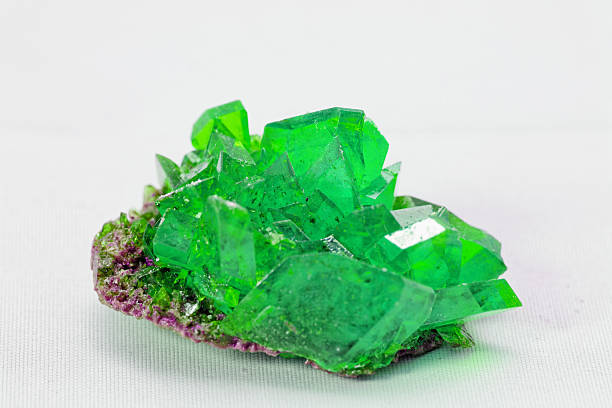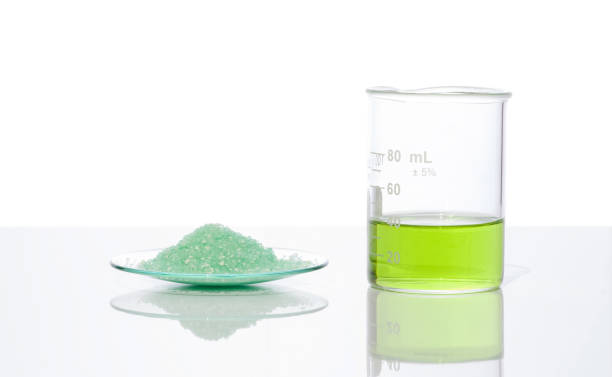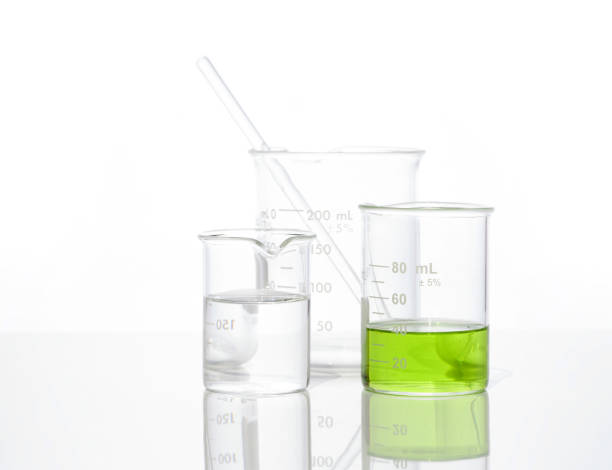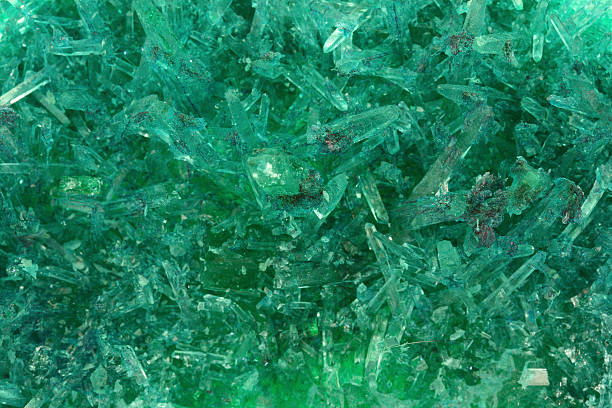Cupric chloride, also called copper(II) chloride, is a key inorganic compound widely used in laboratories, industries, and research. Its chemical formula, CuCl₂, features copper in the +2 oxidation state and two chloride ions. Known for its distinctive green color, high solubility in water, and versatile uses in different chemical processes, this compound has many important applications. In this complete guide, we will examine the properties, preparation methods, structure, uses, safety, and handling of cupric chloride in detail.
Introduction to Cupric Chloride
Cupric chloride (CuCl₂) is a greenish-blue crystalline solid that serves as a key source of copper ions in many reactions. It exists in both anhydrous and dihydrate (CuCl₂·2H₂O) forms. The anhydrous form is more yellowish-brown, while the dihydrate form appears bright green due to hydration.
In nature, cupric chloride occurs as tolbachite (anhydrous) and erianite (dihydrate) minerals. It plays an essential role in analytical chemistry, metallurgy, and the manufacturing of pigments and catalysts.
Chemical Formula and Structure
- Chemical Formula: CuCl₂
- Molar Mass: 134.45 g/mol
- Oxidation State of Copper: +2
Structural Information

Cupric chloride has an ionic lattice structure. Each copper(II) ion is surrounded by two chloride ions, forming a linear geometry in the gaseous phase, while in solid form, it exhibits a distorted octahedral structure due to coordination with additional chloride or water molecules.
Physical Properties of Cupric Chloride
| Property | Description |
|---|---|
| Appearance | Green crystalline solid |
| Odor | Odorless |
| Molar Mass | 134.45 g/mol |
| Melting Point | 498°C |
| Boiling Point | Decomposes before boiling |
| Density | 3.386 g/cm³ (anhydrous) |
| Solubility | Soluble in water, ethanol, and acetone |
| Color | Green (hydrated), Brownish-yellow (anhydrous) |
The hydrated form turns brown upon heating as it loses water molecules, converting into the anhydrous compound.
Chemical Properties of Cupric Chloride
- Reaction with Water:
CuCl₂ dissolves readily in water to form a blue-green solution containing- [Cu(H₂O)₄]²⁺ complex ions. [CuCl₂(s) + 2H₂O(l) → [Cu(H₂O)₄]²⁺ + 2Cl⁻]
- Reaction with Ammonia:
CuCl₂ reacts with ammonia to form a deep blue complex, tetraamminecopper(II) chloride.- [CuCl₂ + 4NH₃ → [Cu(NH₃)₄]Cl₂]
- Reaction with Iron:
When iron is introduced into a cupric chloride solution, copper metal is displaced.- [Fe + CuCl₂ → FeCl₂ + Cu]
- Decomposition:
On heating strongly, cupric chloride decomposes to form copper(I) chloride (CuCl) and chlorine gas (Cl₂).- [2CuCl₂ → 2CuCl + Cl₂↑]
Preparation of Cupric Chloride
Cupric chloride can be prepared by several methods:
a. From Copper Metal and Chlorine Gas
[Cu + Cl₂ → CuCl₂]
This direct combination produces anhydrous cupric chloride.
b. From Copper(II) Oxide and Hydrochloric Acid
[CuO + 2HCl → CuCl₂ + H₂O]
c. From Copper Carbonate and Hydrochloric Acid
[CuCO₃ + 2HCl → CuCl₂ + H₂O + CO₂↑]
d. Industrial Method
In industry, cupric chloride is often obtained as a byproduct of various metallurgical processes, especially during copper refining.
Applications of Cupric Chloride

Cupric chloride has diverse uses in chemical, industrial, and analytical fields:
1. Catalyst in Organic Reactions
- CuCl₂ acts as a catalyst in oxidation and chlorination reactions.
- Used in the Wacker process to oxidize ethylene to acetaldehyde.
2. Etching and Electroplating
- Essential in printed circuit board (PCB) etching for removing excess copper.
- Used in electroplating baths to deposit copper coatings.
3. Pigment and Dye Manufacturing
- CuCl₂ provides a green-blue tint in ceramics, glasses, and textiles.
4. Photography and Printing
- Employed in photoengraving and printing ink formulations.
5. Laboratory Reagent
- Used widely for both qualitative and quantitative analysis in chemistry laboratories.
6. Fungicide and Disinfectant
- In small concentrations, it is used as a fungicidal agent in agriculture.
Health and Safety Information
While cupric chloride is useful, it must be handled carefully due to its toxic and corrosive nature.
Toxicity and Hazards
- Inhalation: May cause respiratory irritation.
- Ingestion: Toxic; can cause nausea, vomiting, and abdominal pain.
- Skin Contact: Causes irritation or burns.
- Eye Contact: Leads to redness and severe irritation.
Safety Precautions

- Wear gloves, goggles, and protective clothing.
- Handle in a well-ventilated area.
- Store in tightly sealed containers away from humidity and sunlight.
- Ensure disposal complies with regional hazardous waste management rules.
Environmental Impact
Cupric chloride can be toxic to aquatic life. Its release into water systems should be strictly controlled. Proper disposal and waste treatment are crucial to prevent soil and water contamination.
Interesting Facts about Cupric Chloride
- It changes color depending on hydration, from brownish-yellow (anhydrous) to bright green (hydrated).
- Used in pyrotechnics to produce blue-green flames.
- Plays a key role in the Wacker oxidation process, a major industrial method for acetaldehyde production.
- The compound exhibits beautiful blue-green fluorescence under certain light conditions in aqueous solution.
Summary
| Aspect | Details |
|---|---|
| Chemical Name | Cupric Chloride |
| Formula | CuCl₂ |
| Appearance | Green crystalline solid |
| Molar Mass | 134.45 g/mol |
| Solubility | Soluble in water, alcohol, and acetone |
| Main Uses | Catalysis, etching, pigment, disinfectant |
| Hazards | Soluble in water, alcohol, and acetone |
Conclusion
Cupric chloride (CuCl₂) is a chemically versatile compound with wide-ranging applications in industry, chemistry, and environmental processes. From catalysis to electroplating, this compound plays a crucial role in modern technology and research. However, due to its toxic nature, it must be handled with proper safety measures to protect human health and the environment.
Understanding its properties, reactions, and applications allows scientists and industries to harness its benefits effectively while minimizing potential risks.
What is the color of cupric chloride?
Introduction to Cupric Chloride
Cupric chloride (CuCl₂) is a greenish-blue crystalline solid that serves as a key source of copper ions in many reactions. It exists in both anhydrous and dihydrate (CuCl₂·2H₂O) forms. The anhydrous form is more yellowish-brown, while the dihydrate form appears bright green due to hydration.
In nature, cupric chloride occurs as tolbachite (anhydrous) and erianite (dihydrate) minerals. It plays an essential role in analytical chemistry, metallurgy, and the manufacturing of pigments and catalysts.
Chemical Formula and Structure
Chemical Formula: CuCl₂
Molar Mass: 134.45 g/mol
Oxidation State of Copper: +2
Structural Information
Cupric chloride has an ionic lattice structure. Each copper(II) ion is surrounded by two chloride ions, forming a linear geometry in the gaseous phase, while in solid form, it exhibits a distorted octahedral structure due to coordination with additional chloride or water molecules.
Physical Properties of Cupric Chloride
| Property | Description |
|---|---|
| Appearance | Green crystalline solid |
| Odor | Odorless |
| Molar Mass | 134.45 g/mol |
| Melting Point | 498°C |
| Boiling Point | Decomposes before boiling |
| Density | 3.386 g/cm³ (anhydrous) |
| Solubility | Soluble in water, ethanol, and acetone |
| Color | Green (hydrated), Brownish-yellow (anhydrous) |
Chemical Properties of Cupric Chloride
Reaction with Water:
CuCl₂ dissolves readily in water to form a blue-green solution containing [Cu(H₂O)₄]²⁺ complex ions. [CuCl₂(s) + 2H₂O(l) → [Cu(H₂O)₄]²⁺ + 2Cl⁻]
Reaction with Ammonia:
CuCl₂ reacts with ammonia to form a deep blue complex, tetraamminecopper(II) chloride. [CuCl₂ + 4NH₃ → [Cu(NH₃)₄]Cl₂]
Reaction with Iron:
When iron is introduced into a cupric chloride solution, copper metal is displaced. [Fe + CuCl₂ → FeCl₂ + Cu]
Decomposition:
On heating strongly, cupric chloride decomposes to form copper(I) chloride (CuCl) and chlorine gas (Cl₂). [2CuCl₂ → 2CuCl + Cl₂↑]
Preparation of Cupric Chloride
Cupric chloride can be prepared by several methods:
a. From Copper Metal and Chlorine Gas
[Cu + Cl₂ → CuCl₂]
This direct combination produces anhydrous cupric chloride.
b. From Copper(II) Oxide and Hydrochloric Acid
[CuO + 2HCl → CuCl₂ + H₂O]
c. From Copper Carbonate and Hydrochloric Acid
[CuCO₃ + 2HCl → CuCl₂ + H₂O + CO₂↑]
d. Industrial Method
In industry, cupric chloride is often obtained as a byproduct of various metallurgical processes, especially during copper refining.
Applications of Cupric Chloride
Cupric chloride has diverse uses in chemical, industrial, and analytical fields:
1. Catalyst in Organic Reactions
CuCl₂ acts as a catalyst in oxidation and chlorination reactions.
Used in the Wacker process to oxidize ethylene to acetaldehyde.
2. Etching and Electroplating
Essential in printed circuit board (PCB) etching for removing excess copper.
Used in electroplating baths to deposit copper coatings.
3. Pigment and Dye Manufacturing
CuCl₂ provides a green-blue tint in ceramics, glasses, and textiles.
4. Photography and Printing
Employed in photoengraving and printing ink formulations.
5. Laboratory Reagent
Used widely for both qualitative and quantitative analysis in chemistry laboratories.
6. Fungicide and Disinfectant
In small concentrations, it is used as a fungicidal agent in agriculture.
Health and Safety Information
While cupric chloride is useful, it must be handled carefully due to its toxic and corrosive nature.
Toxicity and Hazards
Inhalation: May cause respiratory irritation.
Ingestion: Toxic; can cause nausea, vomiting, and abdominal pain.
Skin Contact: Causes irritation or burns.
Eye Contact: Leads to redness and severe irritation.
Safety Precautions
Wear gloves, goggles, and protective clothing.
Handle in a well-ventilated area.
Store in tightly sealed containers away from humidity and sunlight.
Ensure disposal complies with regional hazardous waste management rules.
Environmental Impact
Cupric chloride can be toxic to aquatic life. Its release into water systems should be strictly controlled. Proper disposal and waste treatment are crucial to prevent soil and water contamination.
Interesting Facts about Cupric Chloride
It changes color depending on hydration, from brownish-yellow (anhydrous) to bright green (hydrated).
Used in pyrotechnics to produce blue-green flames.
Plays a key role in the Wacker oxidation process, a major industrial method for acetaldehyde production.
The compound exhibits beautiful blue-green fluorescence under certain light conditions in aqueous solution.
Summary
| Aspect | Details |
|---|---|
| Chemical Name | Cupric Chloride |
| Formula | CuCl₂ |
| Appearance | Green crystalline solid |
| Molar Mass | 134.45 g/mol |
| Solubility | Soluble in water, alcohol, and acetone |
| Main Uses | Catalysis, etching, pigment, disinfectant |
| Hazards | Soluble in water, alcohol, and acetone |
Cupric chloride (CuCl₂) is a chemically versatile compound with wide-ranging applications in industry, chemistry, and environmental processes. From catalysis to electroplating, this compound plays a crucial role in modern technology and research. However, due to its toxic nature, it must be handled with proper safety measures to protect human health and the environment.
Understanding its properties, reactions, and applications allows scientists and industries to harness its benefits effectively while minimizing potential risks.
Is cupric chloride soluble in water?
How is cupric chloride used in PCB etching?
What are the safety precautions for handling cupric chloride?
Is CuCl₂ toxic?
What is the use of CuCl₂?
Introduction to CuCl₂
Cupric chloride (CuCl₂) is a greenish-blue crystalline solid that serves as a key source of copper ions in many reactions. It exists in both anhydrous and dihydrate (CuCl₂·2H₂O) forms. The anhydrous form is more yellowish-brown, while the dihydrate form appears bright green due to hydration.
In nature, cupric chloride occurs as tolbachite (anhydrous) and erianite (dihydrate) minerals. It plays an essential role in analytical chemistry, metallurgy, and the manufacturing of pigments and catalysts.
Chemical Formula and Structure
Chemical Formula: CuCl₂
Molar Mass: 134.45 g/mol
Oxidation State of Copper: +2
Structural Information
Cupric chloride has an ionic lattice structure. Each copper(II) ion is surrounded by two chloride ions, forming a linear geometry in the gaseous phase, while in solid form, it exhibits a distorted octahedral structure due to coordination with additional chloride or water molecules.
Physical Properties of CuCl₂
| Property | Description |
|---|---|
| Appearance | Green crystalline solid |
| Odor | Odorless |
| Molar Mass | 134.45 g/mol |
| Melting Point | 498°C |
| Boiling Point | Decomposes before boiling |
| Density | 3.386 g/cm³ (anhydrous) |
| Solubility | Soluble in water, ethanol, and acetone |
| Color | Green (hydrated), Brownish-yellow (anhydrous) |
Chemical Properties of CuCl₂
Reaction with Water:
CuCl₂ dissolves readily in water to form a blue-green solution containing [Cu(H₂O)₄]²⁺ complex ions. [CuCl₂(s) + 2H₂O(l) → [Cu(H₂O)₄]²⁺ + 2Cl⁻]
Reaction with Ammonia:
CuCl₂ reacts with ammonia to form a deep blue complex, tetraamminecopper(II) chloride. [CuCl₂ + 4NH₃ → [Cu(NH₃)₄]Cl₂]
Reaction with Iron:
When iron is introduced into a cupric chloride solution, copper metal is displaced. [Fe + CuCl₂ → FeCl₂ + Cu]
Decomposition:
On heating strongly, cupric chloride decomposes to form copper(I) chloride (CuCl) and chlorine gas (Cl₂). [2CuCl₂ → 2CuCl + Cl₂↑]
Preparation of Cupric Chloride
Cupric chloride can be prepared by several methods:
a. From Copper Metal and Chlorine Gas
[Cu + Cl₂ → CuCl₂]
This direct combination produces anhydrous cupric chloride.
b. From Copper(II) Oxide and Hydrochloric Acid
[CuO + 2HCl → CuCl₂ + H₂O]
c. From Copper Carbonate and Hydrochloric Acid
[CuCO₃ + 2HCl → CuCl₂ + H₂O + CO₂↑]
d. Industrial Method
In industry, cupric chloride is often obtained as a byproduct of various metallurgical processes, especially during copper refining.
Applications of Cupric Chloride
Cupric chloride has diverse uses in chemical, industrial, and analytical fields:
1. Catalyst in Organic Reactions
CuCl₂ acts as a catalyst in oxidation and chlorination reactions.
Used in the Wacker process to oxidize ethylene to acetaldehyde.
2. Etching and Electroplating
Essential in printed circuit board (PCB) etching for removing excess copper.
Used in electroplating baths to deposit copper coatings.
3. Pigment and Dye Manufacturing
CuCl₂ provides a green-blue tint in ceramics, glasses, and textiles.
4. Photography and Printing
Employed in photoengraving and printing ink formulations.
5. Laboratory Reagent
Used widely for both qualitative and quantitative analysis in chemistry laboratories.
6. Fungicide and Disinfectant
In small concentrations, it is used as a fungicidal agent in agriculture.
Health and Safety Information
While cupric chloride is useful, it must be handled carefully due to its toxic and corrosive nature.
Toxicity and Hazards
Inhalation: May cause respiratory irritation.
Ingestion: Toxic; can cause nausea, vomiting, and abdominal pain.
Skin Contact: Causes irritation or burns.
Eye Contact: Leads to redness and severe irritation.
Safety Precautions
Wear gloves, goggles, and protective clothing.
Handle in a well-ventilated area.
Store in tightly sealed containers away from humidity and sunlight.
Ensure disposal complies with regional hazardous waste management rules.
Environmental Impact
Cupric chloride can be toxic to aquatic life. Its release into water systems should be strictly controlled. Proper disposal and waste treatment are crucial to prevent soil and water contamination.
Interesting Facts about Cupric Chloride
It changes color depending on hydration, from brownish-yellow (anhydrous) to bright green (hydrated).
Used in pyrotechnics to produce blue-green flames.
Plays a key role in the Wacker oxidation process, a major industrial method for acetaldehyde production.
The compound exhibits beautiful blue-green fluorescence under certain light conditions in aqueous solution.
Summary
| Aspect | Details |
|---|---|
| Chemical Name | Cupric Chloride |
| Formula | CuCl₂ |
| Appearance | Green crystalline solid |
| Molar Mass | 134.45 g/mol |
| Solubility | Soluble in water, alcohol, and acetone |
| Main Uses | Catalysis, etching, pigment, disinfectant |
| Hazards | Soluble in water, alcohol, and acetone |
Cupric chloride (CuCl₂) is a chemically versatile compound with wide-ranging applications in industry, chemistry, and environmental processes. From catalysis to electroplating, this compound plays a crucial role in modern technology and research. However, due to its toxic nature, it must be handled with proper safety measures to protect human health and the environment.
Understanding its properties, reactions, and applications allows scientists and industries to harness its benefits effectively while minimizing potential risks.
What are the applications of CuCl₂?
Cupric chloride has diverse uses in chemical, industrial, and analytical fields:
1. Catalyst in Organic Reactions
CuCl₂ acts as a catalyst in oxidation and chlorination reactions.
Used in the Wacker process to oxidize ethylene to acetaldehyde.
2. Etching and Electroplating
Essential in printed circuit board (PCB) etching for removing excess copper.
Used in electroplating baths to deposit copper coatings.
3. Pigment and Dye Manufacturing
CuCl₂ provides a green-blue tint in ceramics, glasses, and textiles.
4. Photography and Printing
Employed in photoengraving and printing ink formulations.
5. Laboratory Reagent
Used widely for both qualitative and quantitative analysis in chemistry laboratories.
6. Fungicide and Disinfectant
In small concentrations, it is used as a fungicidal agent in agriculture.
